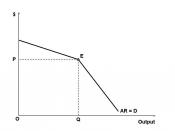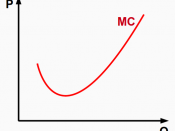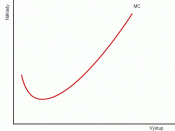Microeconomic Theory
"Price Policy in Oligopoly"
Instr.: Dr. Michael Chletsos
Submitted by:
Maria Soulimioti
Price-output behavior in Oligopoly
The kinked demand curve: This model was developed in 1939 by the economist Sweezy. It assumes that an oligopolist will expect rival firms to follow any price decrease it makes but not follow any increase. Thus the elasticity of demand for the firm's product is much greater above the ruling price than below it, and hence there is a kink in the demand curve faced by the firm.
For straight line demand curves the marginal revenue line lies halfway between the demand curve and the vertical axis. It is thus easy to show that the kink in the demand curve implies a discontinuity, i.e. a sudden drop, in the marginal revenue curve of the firm.
Marginal cost could thus vary greatly but still pass through this discontinuity in marginal revenue. Equally, changes in market demand could shift demand curves in and out without affecting the height of the kink.
In short, profit maximizing at MC=MR could leave price unaffected despite considerable fluctuations in costs and demand.
The model has been used to explain why prices appear to fluctuate less in oligopolistic markets than in competitive markets. The model has serious flaws, however: again it implies a knowledge of marginal costs and revenue not possessed by real firms; it is not clear that entrepreneurs hold such pessimistic expectations of the reactions of their competitors: the evidence on price stickiness is not as clear cut as many believe. But the greatest flaw is that the model does not explain price determination, i.e. it does not explain how the prevailing price was established or what happens when the price is eventually changed.
Collusive Pricing: Rivalry usually results in lower profits than could be...


